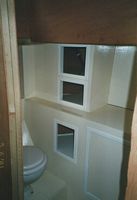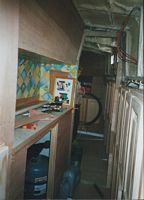So the question now was where to begin. The last three years were spent on steel work and now I had to re program my mind to think about the various sub systems that I needed to install before launch.
 First thing was to fix all the batons onto the frames, bulkheads and floor beams. These in turn would take the plywood covering and this in turn would take the furniture fixings. I worked out that I needed 500m of 50mm by 25mm wood for the batons.
First thing was to fix all the batons onto the frames, bulkheads and floor beams. These in turn would take the plywood covering and this in turn would take the furniture fixings. I worked out that I needed 500m of 50mm by 25mm wood for the batons.
This arrived in due course and I started the long drilling, painting and bolt tightening operation that was required to fit all of the baton wood.I had seriously underestimated the amount of wood required and in the end it took 1600m of wood to complete the battening. That’s a mile of wood just for that.
Next I painted the bilge area with three coats of bilge paint. The next job was to fit the 25mm marine plywood which would be  the side and bottom of the diesel and water tank mounts. These were fastened in place with stainless steel screws and nuts and bolts.Meanwhile the tanks had arrived and they were mounted in place. Then the plumbing was started.
the side and bottom of the diesel and water tank mounts. These were fastened in place with stainless steel screws and nuts and bolts.Meanwhile the tanks had arrived and they were mounted in place. Then the plumbing was started.
 All plastic fittings where used including plastic tube for cold and hot water. Once the plumbing was competed and tested the diesel tanks were connected and diesel fuel hose was run into the engine room. Next followed the bilge pumps and their respective hoses.
All plastic fittings where used including plastic tube for cold and hot water. Once the plumbing was competed and tested the diesel tanks were connected and diesel fuel hose was run into the engine room. Next followed the bilge pumps and their respective hoses.
After this was completed a gulper toilette pump was fitted and a number of 3 way valves were connected in such a way that the pump could discharge either from the black water holding tank or from the grey water holding tank through a 2” seacock.
The cabin sole was fixed to the beams and cut outs were added to enable access to the various hatches. It was now time to order the masts.The reason why I say order is that initially we were going to make them ourselves.
However, I had been trying to buy two untreated telegraph poles for a couple of years now with no success. All were already dipped when they arrived in the UK so we had to go to plan B.
Plan B was that Noble Masts of Bristol fame were to build us two hollow masts one 14 meters and the other 11 meters long. To be delivered complete with masthead fittings by second week in July. No problems Noble Masts said so we placed the order.
Cost £6000 for the two. Cheap at the price. Now that all of the work under the cabin sole had been finished and the cabin sole had been laid I could get a company to spray foam insulate from port cabin sole line all the way up and over to the cabin sole line on the starboard side.
 The cost for this was £1400.This was completed in a day. Of course the operator of the spraying equipment had little control over the spraying operation and all of the batons were covered an inch thick with foam. This had to be removed by scraping. This was one of the worst jobs I had to do. It took a complete week to complete.
The cost for this was £1400.This was completed in a day. Of course the operator of the spraying equipment had little control over the spraying operation and all of the batons were covered an inch thick with foam. This had to be removed by scraping. This was one of the worst jobs I had to do. It took a complete week to complete.
The thickness of the foam ranged from 50mm to 75mm and this £1400 was later to be one of the best money spent in the build.
